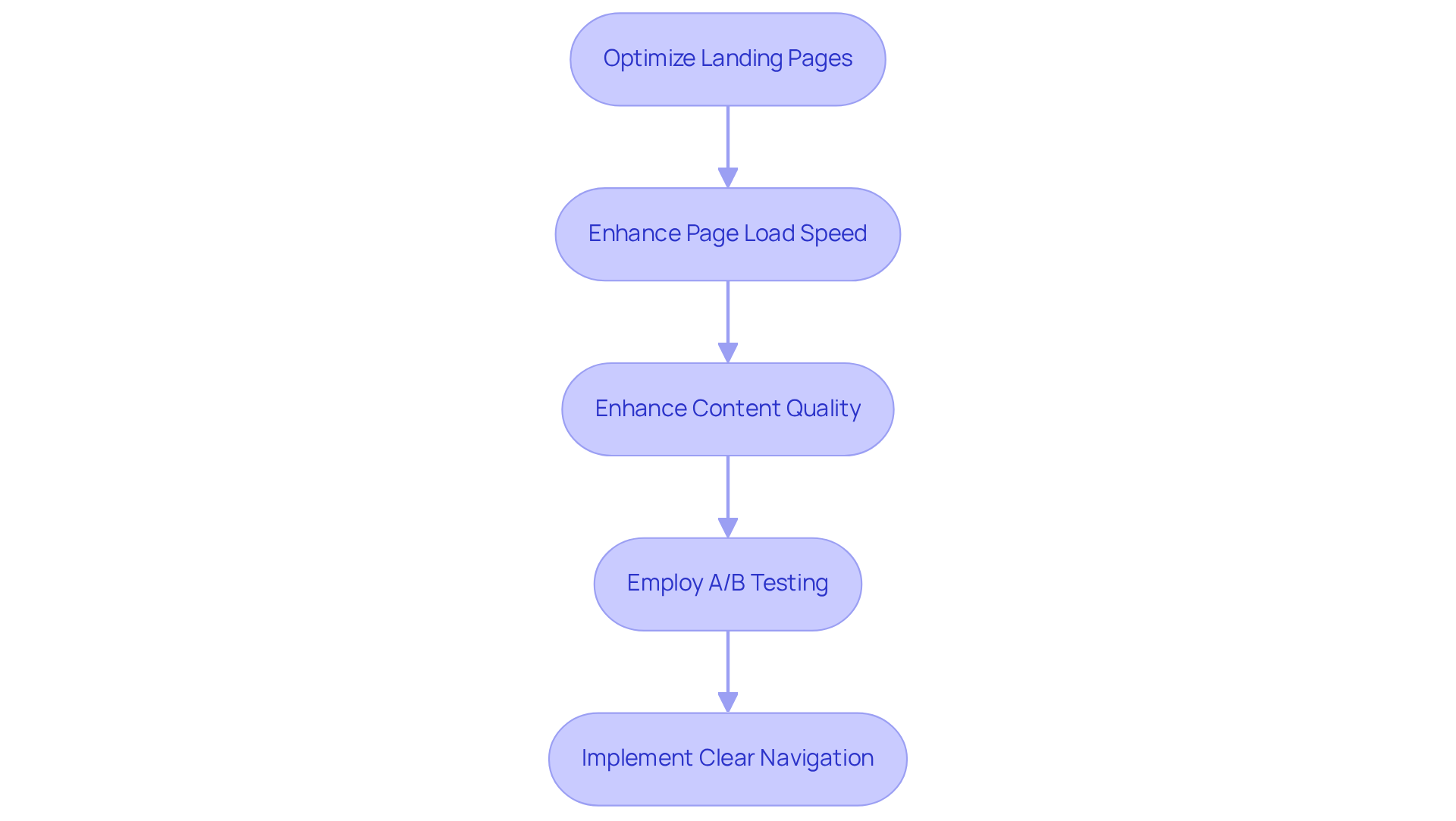
Overview
Google Analytics bounce rate is a critical metric that measures the percentage of visitors who leave a website after viewing only one page. This statistic serves as a direct indicator of how effectively a site engages its audience. For direct-to-consumer (DTC) brands, understanding and addressing bounce rate is paramount; a high bounce rate can signal underlying issues with user experience or content relevance.
To enhance user engagement and conversion rates, it is essential to optimize this metric. Strategies such as:
- Improving landing pages
- Increasing page load speed
can significantly impact how visitors interact with the site. By taking decisive action to address these areas, brands can foster a more engaging online environment, ultimately driving higher conversion rates and customer satisfaction.
Introduction
Understanding the dynamics of user engagement is paramount for any online business, particularly for Direct-to-Consumer (DTC) brands navigating a competitive digital landscape. One key metric that reveals the effectiveness of a website in capturing and retaining visitor interest is the bounce rate—a critical measure indicating the percentage of visitors who leave after viewing just one page.
This article explores the significance of bounce rate for DTC brands, highlighting its dual role as a reflection of user satisfaction and its impact on conversion rates and overall business success.
However, with numerous factors influencing this metric, the pressing question remains: how can brands effectively reduce bounce rates and enhance user experience to drive sales?
Define Bounce Rate in Google Analytics
What is Google Analytics bounce rate? It is the term used to describe the proportion of visitors who exit a website after viewing only one page, without further interaction. Understanding this metric is crucial for analyzing user behavior. A high bounce rate may lead to the question of what is Google Analytics bounce rate, as it indicates that visitors are not finding what they expected or that the content lacks sufficient engagement.
This measurement is calculated by dividing the number of single-page sessions by the total number of entries to the site. This formula provides a clear indicator of how effectively a website retains the attention of its visitors.
By monitoring bounce rates, website owners can gain valuable insights into user engagement and make informed decisions to enhance content and improve user experience.

Contextualize Bounce Rate for DTC Brands
For DTC companies, abandonment frequency serves as a crucial performance measure, reflecting how effectively their website meets consumer expectations. In the fiercely competitive online landscape, a low exit frequency is often associated with successful marketing strategies and engaging content. Notably, Parah Group has successfully aided companies like STRNG Seeds and Grab Green in improving their exit statistics by implementing tailored strategies such as personalized landing pages and enhanced product presentations, resulting in a reduction of exit percentages by up to 30%.
DTC companies must carefully consider factors such as website design, loading speed, and the relevance of landing pages to their target audience. A significant decline in traffic can signal underlying issues that necessitate immediate attention, such as misaligned messaging or subpar user experience—both of which can directly impact sales and customer loyalty.
By focusing on reducing drop-off metrics through innovative Conversion Rate Optimization (CRO) tactics, companies can enhance their overall profitability and drive substantial revenue growth.

Analyze the Impact of Bounce Rate on User Engagement and Conversions
Bounce frequency serves as a critical metric that directly influences user engagement and conversion rates for DTC companies. High departure rates often signal that visitors are not interacting with the content, leading to significant missed opportunities for conversions. For instance, Glamnetic, a beauty brand, successfully reduced its abandonment rate by 77.48% through performance enhancements, which directly contributed to increased sales and customer acquisition costs. Similarly, Sophie's Shoppe experienced a 248% boost in organic search traffic and achieved a remarkable 93% decrease in visitor departures after revamping its SEO strategy. These examples underscore the positive impact of optimizing visitor retention on sales.
Conversely, lower activity levels typically indicate that visitors are navigating multiple pages, thereby increasing the likelihood of completing a purchase. This relationship is crucial; nearly half of U.S. consumers abandon their carts due to unexpected costs or a lack of trust signals, such as secure payment badges and customer reviews. This highlights the importance of providing a seamless user experience.
Brands must closely monitor what is google analytics bounce rate, as it serves as a barometer for the effectiveness of their marketing strategies and website design. Tools like Hotjar and Crazy Egg can aid in visualizing visitor experiences and pinpointing areas for improvement. By optimizing these elements, DTC companies can enhance user engagement, ultimately driving higher conversion rates and boosting overall sales.

Implement Strategies to Reduce Bounce Rate and Enhance User Experience
To significantly reduce bounce rates and enhance user experience, DTC brands must adopt a series of strategic initiatives:
-
Optimize Landing Pages: It is imperative that landing pages align closely with the ads or links directing visitors, featuring clear calls to action that guide users effectively.
-
Enhance Page Load Speed: The speed at which pages load is critical; sluggish sites not only frustrate visitors but also contribute to increased exit rates.
-
Enhance Content Quality: Producing engaging and valuable content is essential. Content that resonates with the target audience encourages deeper exploration of the site.
-
Employ A/B Testing: Regularly testing different versions of web pages is vital to uncover which elements lead to reduced exit frequencies, allowing for informed adjustments.
-
Implement Clear Navigation: A simplified navigation structure is crucial, enabling users to swiftly locate the information they seek.
By focusing on these essential strategies, DTC brands can cultivate a more engaging online experience, which can help answer the question of what is google analytics bounce rate by driving lower bounce rates and higher conversion rates.

Conclusion
Understanding the bounce rate in Google Analytics is essential for Direct-to-Consumer (DTC) brands aiming to enhance user engagement and drive conversions. This metric serves as a critical indicator of how well a website retains visitor interest, with high bounce rates often signaling issues in content relevance or user experience. By effectively analyzing and addressing bounce rates, brands can create more engaging online environments that not only attract visitors but also encourage them to explore further.
The article highlights several key strategies for reducing bounce rates, including:
- Optimizing landing pages
- Improving page load speed
- Enhancing content quality
Real-world examples demonstrate the significant impact that these tactics can have on user engagement and conversion rates. Brands like Glamnetic and Sophie's Shoppe have successfully leveraged these strategies to drastically lower their bounce rates, leading to increased sales and enhanced customer acquisition.
Ultimately, DTC brands must prioritize understanding and improving their bounce rates to thrive in a competitive digital landscape. By implementing effective strategies and utilizing analytical tools, brands can foster a seamless user experience that not only captivates visitors but also drives long-term customer loyalty. Taking action on these insights can transform bounce rate from a mere statistic into a powerful tool for growth and profitability.
Frequently Asked Questions
What is bounce rate in Google Analytics?
Bounce rate in Google Analytics refers to the proportion of visitors who leave a website after viewing only one page, without any further interaction.
Why is understanding bounce rate important?
Understanding bounce rate is crucial for analyzing user behavior, as a high bounce rate may indicate that visitors are not finding what they expected or that the content lacks sufficient engagement.
How is bounce rate calculated?
Bounce rate is calculated by dividing the number of single-page sessions by the total number of entries to the site.
What insights can website owners gain from monitoring bounce rates?
By monitoring bounce rates, website owners can gain valuable insights into user engagement, which can help them make informed decisions to enhance content and improve user experience.
FAQs











